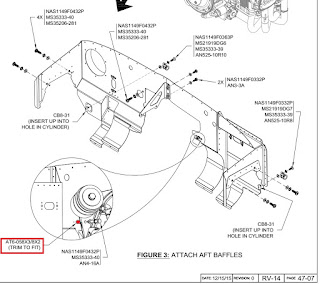The VA-132-2 Snorkel actually takes a significant amount of work to complete.
First, the cap for the fuel injector is removed (left) then the fuel injector is mounted (right).
The Snorkel is man-handled into place and clamped down.
Then the outline of the fuel injector's flange is traced onto the Snorkel's flange to ensure it is centered. Then, using a template provided in the kit, the round flange is cut into the square shape necessary to fit the injector servo. The picture below shows how well the pieces were centered and the good, clean trimming of the flage.
Next the top of the Snorkel is cut to length (not shown) and match drilled into the CB-00020 Air Filter Frame.
Then the two pieces are properly adhered to each other with an epoxy-flox mixture.
Next a 2.75" diameter hole needs to be cut into the left side of the Snorkel to accommodate the alternate air input system via the V-192A Alternate Air Inlet. I used a hole saw with very light pressure (left) and obtained great results.
Here is the crimp on the Alternate Air Inlet showing the fit of the VA-192B Filter Bypass Door.
The Alternate Air Inlet is properly epoxy-floxed into place.
A gasket is necessary to seal (left) to seal the Snorkel to the fuel injector (right). I replaced the one that was installed on the crated engine. That part number is 77504 and is
available from Aircraft Spruce. The gasket was lubricated with oil, the Snorkel installed and the bolts were later safety-wired.
Next the CB-00034 Right Air Ramp Cone must be bent into shape. First the template is adhered to the aluminum piece (top left) then it is slowly bent into the cone shape (top right, bottom left) until the piece conforms properly (bottom right).
The cone is then match drilled into the CB-00007 Right Air Ramp (left) and riveted into place (right). I will probably later remove the rivets around the Vent DL-03 and Vent Screen 3x3 and replace with news that have their manufactured heads on top.
A similar exercise is done on the right, yielding a properly fitting CB-00020 Air Filter Frame.
Here is how the alternate air inlet is ultimately situated prior to attaching the cable.











































